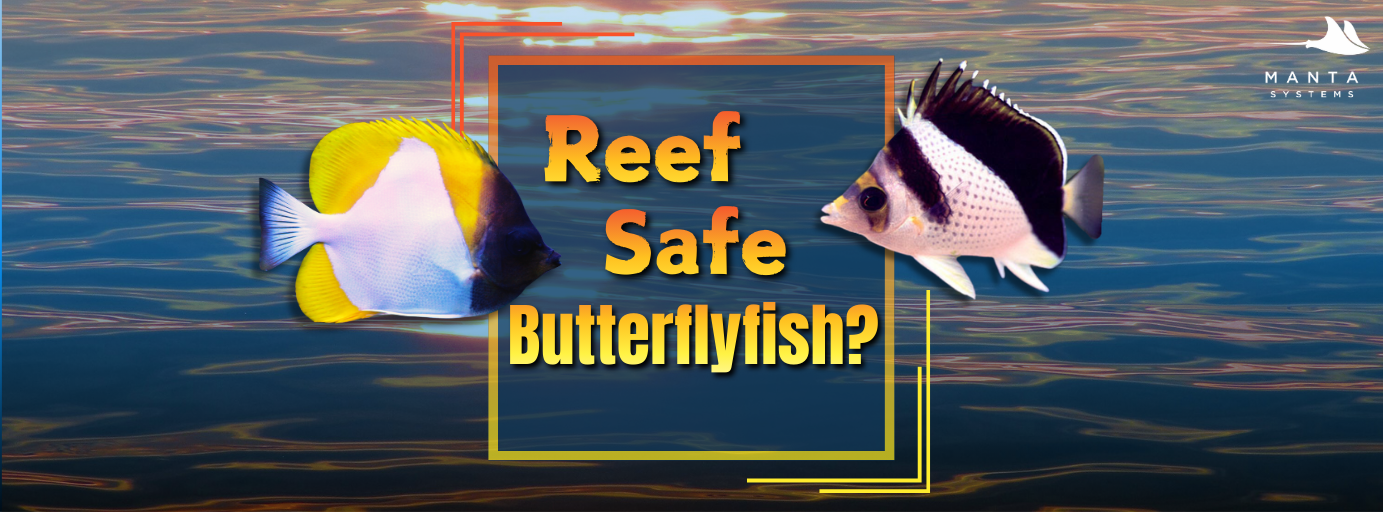
𝐓𝐡𝐞 𝐁𝐮𝐭𝐭𝐞𝐫𝐟𝐥𝐲𝐟𝐢𝐬𝐡 𝐃𝐢𝐥𝐞𝐦𝐦𝐚: 𝐅𝐢𝐧𝐝𝐢𝐧𝐠 𝐚 𝐓𝐫𝐮𝐥𝐲 𝐑𝐞𝐞𝐟-𝐒𝐚𝐟𝐞 𝐁𝐞𝐚𝐮𝐭𝐲
Introduction
Let's be honest: we've all coveted a butterflyfish. That iconic silhouette, the bold patterns, the graceful glide—it's the picture of a living reef. As the head of an aquarium, my responsibilities are vast, however, I always seem to find a reason to be the one who cleans the butterflyfish tanks. I really love to watch their beautiful swimming patterns.
But here's the heartbreaking truth that many hobbyists learn the hard way: that dream often ends with a half-eaten Scoly or a decimated Zoanthid colony. The reality is, most of these beauties are hardwired to eat coral. But don't give up hope just yet.
Why This is So Tricky
It all comes down to what they're designed to eat. Species with those long, delicate snouts and bristle-like teeth are essentially precision instruments for plucking polyps from coral skeletons. Others, with smaller mouths, are natural plankton hunters that spend their lives in the water column, largely ignoring the rockwork. The single most important rule is this: you can't fight millions of years of evolution. Let's be honest, corals taste amazing (at least to a butterflyfish). Trying to get one to ignore the gourmet buffet you've laid out is a pretty tough ask!
Debunking 4 Common Butterflyfish Myths
Before we get to the species list, let's clear up some of the most persistent and dangerous myths that lead hobbyists astray.
Myth 1: "A well-fed fish won't bother corals."
This is the most common and costly myth. While a hungry fish is more likely to nip, a butterflyfish hardwired to eat coral polyps sees them not just as food, but as a natural behavior. It's like offering a house cat a bowl of kibble and expecting it to ignore a bird fluttering past the window. The instinct to hunt (or pick) is innate and not solely driven by hunger.
Myth 2: "They'll only eat the pest Aiptasia."
While the Copperband Butterflyfish has earned its reputation as an Aiptasia-eater, this is not a guarantee. Some individuals will ignore Aiptasia completely. Worse, many that do eat the pests will eventually develop a taste for more desirable animals like clam mantles, feather dusters, and LPS polyps. Never purchase a fish solely for pest control without a backup plan.
Myth 3: "They'll 'learn' to eat prepared foods and forget about corals."
A butterflyfish that accepts frozen Mysis is a huge victory, but it doesn't "erase" its genetic programming. Many hobbyists report a "honeymoon period" where the fish eats prepared foods and leaves corals alone, only to find it suddenly sampling corals weeks or months later as its natural instincts resurface.
Myth 4: "If it nips at first, it will stop once it settles in."
The opposite is almost always true. Initial nipping is a major red flag. This is the fish exhibiting its natural behavior from day one. "Settling in" typically makes the behavior worse, not better, as the fish becomes bolder and more comfortable in its environment.
Your Safest Bets (The Short List)
If you're determined to add one, a tiny handful of species are widely considered the safest choices, especially for SPS-dominated tanks where there are fewer fleshy polyps to tempt them.
Your most reliable options include:
-
Pyramid Butterflyfish (Hemitaurichthys polylepis): This is your number one bet. They're planktivores that form beautiful groups and spend their time picking at the water column, rarely even glancing at corals.
-
Zoster Butterflyfish (Hemitaurichthys zoster): A striking black-and-white version of the Pyramid with the same impeccable feeding habits.
-
The Deepwater Gems: Species like Tinker's Butterflyfish (Chaetodon tinkeri) and Burgess's Butterflyfish (Chaetodon burgessi) have stellar reputations, though they can be pricey and sometimes prefer slightly cooler water.
I've kept Pyramids in my own SPS-dominated reef for years with zero issues. They're peaceful, active, and utterly ignore corals. They're the closest thing to a "sure bet" you'll find.
The Gray Area: Proceed with Extreme Caution
This is where things get interesting—and where you'll find wildly different stories from other hobbyists. Success with these species isn't guaranteed; it depends on the individual fish's personality and, most importantly, your feeding regimen.
-
The Copperband Butterflyfish (Chelmon rostratus): The classic example. Everyone wants one for their Aiptasia-eating prowess, and many are model citizens. But I've also seen them develop a taste for clam mantles and fleshy LPS overnight. Their biggest challenge? Many are notoriously picky eaters and slowly starve in tanks with competitive tankmates.
-
Longnose Butterflyfish (Forcipiger spp.): Often successful in large, mature reefs, but some individuals will relentlessly pick at tube worms and certain corals. They need space and peace.
-
Klein's Butterflyfish (Chaetodon kleinii): Sometimes recommended, but I'm skeptical. Many hobbyists report them eventually sampling soft corals and zoas. They're hardy, which is a problem if they turn destructive.
The "Absolutely Not" List (Reef Tank Nightmares)
Some species are so specialized for eating coral that putting them in a reef tank is simply offering an all-you-can-eat buffet. I learned this lesson the hard way with a Raccoon Butterflyfish that decimated my Duncan colony in 48 hours. Avoid these at all costs:
-
Ornate Butterflyfish (Chaetodon ornatissimus): A dedicated coral-eating machine.
-
Raccoon Butterflyfish (Chaetodon lunula): Hardy, but a known nipper of soft corals, LPS, and even SPS.
-
Teardrop Butterflyfish (Chaetodon unimaculatus), Lined Butterflyfish (Chaetodon lineolatus), and most other Chaetodon species: If it's described as "corallivorous" in scientific texts, believe it.
The Real Challenge: The Art of Weaning
This is where most people fail. Getting a new butterflyfish to eat is a delicate art that requires patience and a solid plan. A hungry butterflyfish will always find a snack, and your corals are on the menu.
Step 1: The Non-Negotiable Quarantine Tank
Don't even think about skipping this. A QT lets the fish recover from shipping stress without competition. It's also your only chance to monitor its health and eating habits closely. A stressed fish won't eat, and a butterflyfish that doesn't eat in the first week is a major red flag.
Step 2: The Weaning Process
-
Start with Live Food: Live adult brine shrimp or blackworms are irresistible and will kickstart their feeding response.
-
The "Cocktail" Method: In a feeding station, mix live food with high-quality frozen mysis or brine shrimp. The movement of the live food tricks them into trying the frozen stuff.
-
Clam on the Half-Shell: The 'clam on the half-shell' technique isn't just a hobbyist trick; it's a standard practice for a reason—it works with even the most stubborn wild-caught specimens. A fantastic food, especially for Copperbands. The natural picking behavior is strong.
-
Go Slow: Over days or weeks, slowly increase the ratio of frozen to live food. Soaking food in a vitamin supplement like Selcon can boost its appeal.
Feeding frequency is critical. These fish have fast metabolisms. Grazers like Copperbands need 3-5 small meals a day. An auto-feeder can be a lifesaver.
Step 3: Tank Setup: Getting the Environment Right
Butterflyfish need specific conditions. They're active swimmers, so a 125-gallon tank that's long is better than a tall one. They need a mix of open swimming space and rockwork with hiding spots. Most importantly, they need peaceful tankmates. Aggressive fish like triggers or even boisterous wrasses will stress them out and outcompete them for food.
Troubleshooting Eating
Problem: New Butterflyfish Isn't Eating
-
Days 1-2: Don't panic. Offer live adult brine shrimp or blackworms in a quiet, low-flow area of the quarantine tank. Do not hover.
-
Days 3-4: If it ignores food in the water column, try target feeding using a long baster or turkey baster. Place the food (live or frozen) directly in front of it. Also, try clams on the half-shell or live gut-loaded ghost shrimp; the movement and natural presentation can trigger a feeding response.
-
Day 5+ (No Success): This is a critical stage.
-
Check Water Parameters: Ensure ammonia and nitrite are 0. Even slight traces can suppress appetite.
-
Assess for Disease: Look closely for signs of parasites (ich, velvet) or bacterial infections. A fish feeling sick will not eat.
-
Try a Mirrored Tank: In my years of acclimating delicate specimens, I've found that a mirrored QT tank can sometimes trigger a competitive feeding response that saves a fish's life.
-
Last Resort: If the fish is visibly emaciating (a pinched belly, sharp spine), you may need to treat with an anti-parasitic medication like Praziquantel (Prazipro) in case internal parasites are the issue, but this is stressful.
-
Problem: It Was Eating, But Now It's Stopped
-
Cause 1: Bullying. Are tankmates outcompeting it? Is it being chased? Even passive aggression from a dominant wrasse or dottyback can stress a butterflyfish into hiding and not eating.
-
Solution: Use a feeding station (a clear plastic container with holes) to give it a safe space to eat. Observe tank dynamics closely and consider rehoming an aggressive tankmate.
-
Cause 2: Water Quality Deterioration. Have nitrates or phosphates spiked? Was there a temperature swing?
-
Solution: Test all parameters and perform a water change.
-
Cause 3: It's Started Nipping Corals. This is a bad sign. It may be filling up on your corals and losing interest in prepared foods.
-
Solution: You must make a decision: rehome the butterflyfish or accept the coral losses.
Problem: It's Eating Well, But Nipping at Corals
-
The Reality: This is the hardest problem to solve. You cannot "train" this out of them.
-
Step 1: Identify the trigger. Is it a specific coral type (e.g., all Zoanthids, all Acans)? Is it only when it's hungry between feedings?
-
Step 2: Increase feeding frequency. An auto-feeder that dispenses a small amount of food 4-5 times a day can keep it occupied.
-
Step 3: If the nipping continues, you have only two ethical choices:
-
Rehome the Butterflyfish. This is the safest choice for your reef.
-
Remove the Target Corals. This is only a solution if the fish only nips one specific type of coral you are willing to sacrifice.
-
Problem: It's Hiding Constantly and Won't Come Out to Eat
-
Cause: This is almost always a environmental or social stress issue. The tank is too bare, the flow is too high, or the tankmates are too boisterous.
-
Solution: Ensure your aquascape has numerous, easily accessible caves and overhangs. Consider temporarily reducing flow during feeding times. If the tankmates are the issue, you may need to rearrange the rockwork to break up territories or, as a last resort, rehome the stressor.
Conclusion
Adding a butterflyfish to a reef tank is one of the hobby's ultimate advanced challenges. Before you take the plunge, ask yourself:
-
Is my tank large enough and mature (over 1 year old)?
-
Am I prepared to feed multiple times a day, every day?
-
Do I have a proper quarantine setup?
-
Am I ready to rehome the fish if it doesn't work out?
If you answered "no" to any of these, admire these fish from afar for now. But if you answered with a confident "yes," then careful selection from the "safest bets" list, dedicated feeding, and a solid backup plan can lead to one of the most stunning and rewarding achievements in reefkeeping. Just remember: patience and preparation are everything.
Happy Reefing!
References:
Allen, Gerald R., et al. Butterfly and Angelfishes of the World. Volume 1. Wiley-Interscience, 1980.
Debelius, Helmut, and Rudie H. Kuiter. World Atlas of Marine Fishes. 3rd ed., IKAN-Unterwasserarchiv, 2006.
Michael, Scott W. *Reef Aquarium Fishes: 500+ Essential-to-Know Species*. Microcosm Ltd., 2001.







.png)